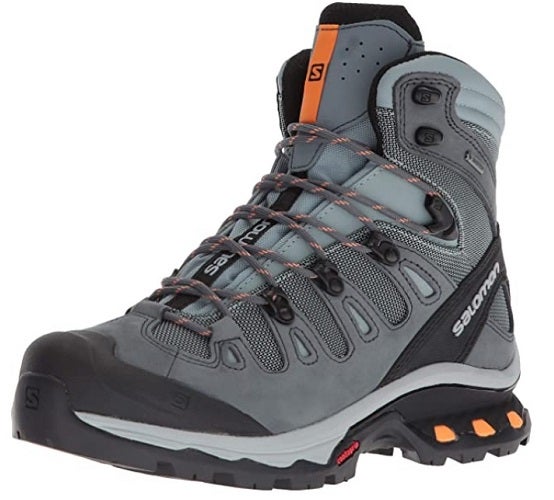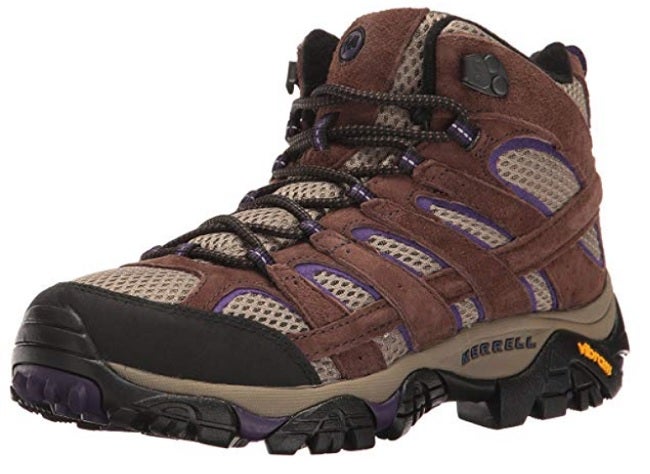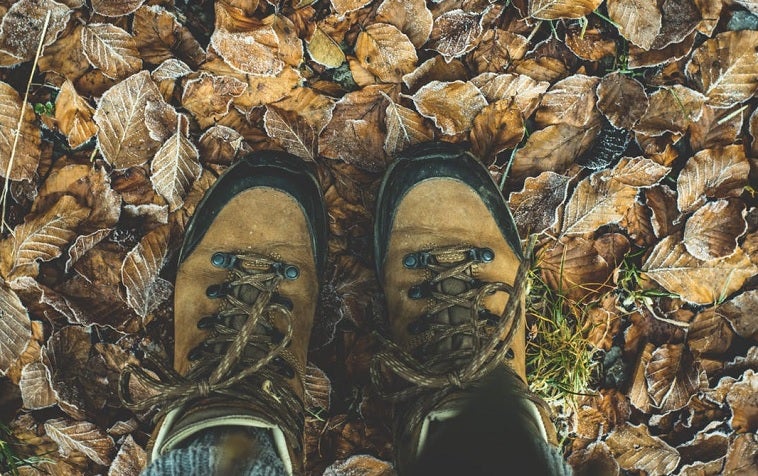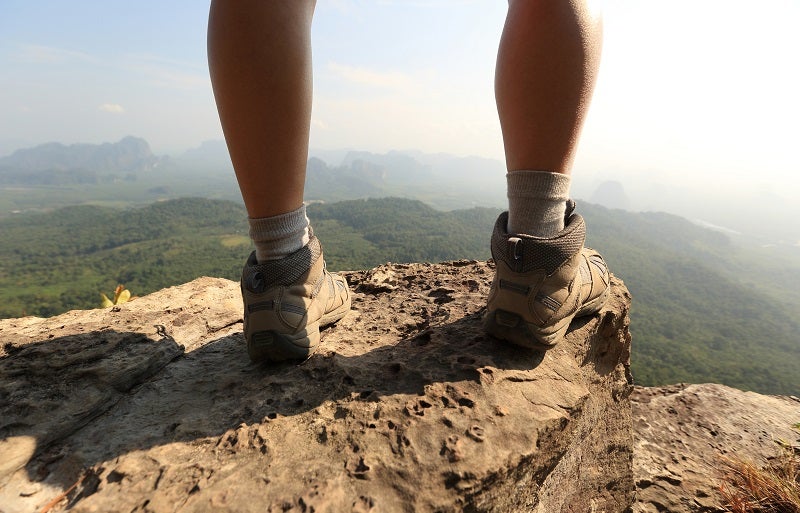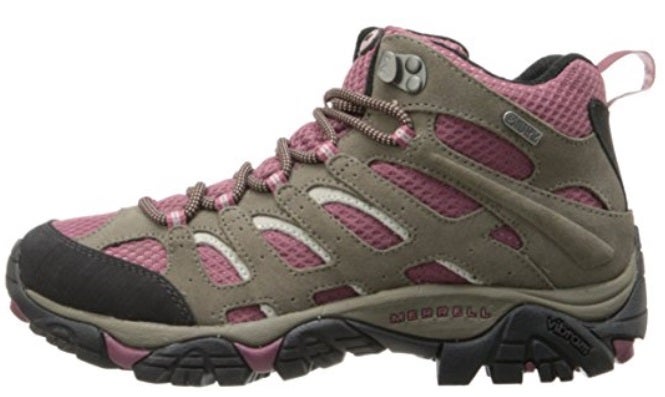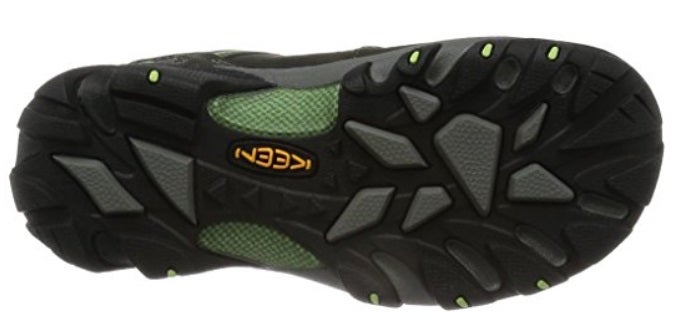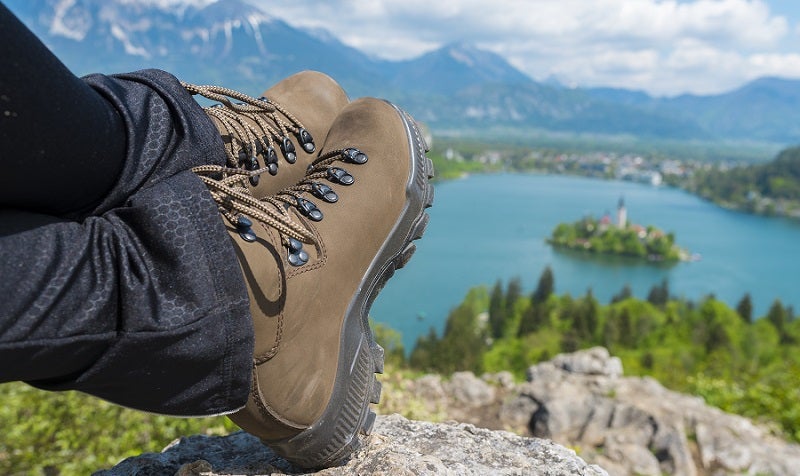
Our Editors independently research, test, and rate what we feel are the best products. We use affiliate links and may receive a small commission on purchases.
Ladies can have a particularly difficult time finding good outdoor footwear. It sometimes even seems as if the outdoor industry just isn’t paying attention to the specific needs and wants of the female hiking community.
While it’s tough to find a good pair of hiking boots for women, I’m going to do my best to help provide some insight on the process.
Ladies, you don’t have to settle for poor quality hiking footwear. If you’re looking for the best Women’s hiking boots, just stick to your guns and keep looking.
There are several great outdoor footwear makers out there producing quality Women’s waterproof hiking boots.
Best Hiking Boots For Women
For more of my women’s hiking gear recommendations, have a look through these popular Outside Pursuits guide links: Women’s Hiking Pants, Women’s Hiking Backpacks, Hiking Baby Carriers.
Quick Answer: The 7 Best Rated Women’s Hiking Boots
- Salomon Quest 4D 3 GORE-TEX Women’s Boots
- Merrell Women’s Moab Mid Hiking Boot
- Columbia Women’s Newton Ridge Plus Hiking Boot
- KEEN Women’s Targhee II Mid Waterproof Hiking Boot
- Ahnu Women’s Montara Waterproof Boot
- Manfen Women’s Mid-Rise Waterproof Hiking Boot
- Lowa Women’s Renegade GTX Mid Hiking Boot
Women’s Hiking Boot Reviews
Our reviews of the top rated hiking boots for women with our guide and comparison table will help you choose the right pair for you.
Best Women’s Waterproof Hiking Boots
#1 Salomon Quest 4D 3 GORE-TEX Women’s Boots
- Mesh & leather uppers
- Hight cut design for ankle support and stability
- Cushioned with running shoe adapted technology
- Gore-Tex waterproofing
This is a solid, high cuff hiking boot with waterproof liner, toe cap, and many other great hiking features.
Frontal toe box is a rubber bumper for protecting the foot from sticks, roots, rocks and other objects which might otherwise cause harm to a hiker.
Contragrip soles are some of the best on the market and Salomon is rocking a great multi-layer sole for this boot along with Gore-Tex for breathabilty.
One thing I really dig about this boot is that it’s offered in several colors and variations which are awesome for getting the right look. If you’re going to pay top dollar, you might as well have a custom style, right?
Leather and fabric construction as well as over the ankle, padded and reinforced cuff for extra protection make this a great pair of boots for all day hiking and backpacking.
They are an excellent choice for beginner or experienced hikers looking for a pair of good women’s waterproof hiking boots.
Best Lightweight Women’s Hiking Boots
#2 Merrell Moab 2 Mid Ventilator Women’s Review
- Lightweight leather and textile uppers
- EVA contoured footbed
- Vibram sole for excellent traction
- Breathable mesh panels and aggressive lugged sole
A mid hiking boot falls somewhere between a full-size hiking boot and a trail runner. These aren’t as lightweight or comfy as a trail runner, but they’re also not nearly as beefy and cumbersome as a full-size hiking boot.
There are a couple trade-offs with this. First, you lose the over the ankle protection of a larger boot with things like, ankle support and abrasion resistance on rocks or roots.
Second, with a lower cut this boot is going to let in water from puddles or streams more easily than a taller boot.
The waterproof breathable membrane from Merrell make this pair of Women’s waterproof hiking boots suitable for wet and muddy conditions but not crossing streams.
These are good things to keep in mind when considering a mid-cut boot.
A toe cap brings in all the major features we’re looking for with a Vibram sole and another solid contender on our list for a pair of lightweight hiking boots.
Best Budget Women’s Hiking Boots
#3 Columbia Women’s Newton Ridge Hiking Boot Review
- Full grain leather for waterproofness and durability
- mnigrip lugged outsolefor traction
- Fully waterproof hiking boot
- Compression-molded EVA foam midsole for support
Columbia has always earned my respect for producing high quality outdoor products at a reasonable price compared to many other competitors.
True to nature, they’re at it again, delivering these women’s trekking boots.
Leather and synthetic material combination provides durability, flexibility, and reliability. Using an in-house Columbia rubber sole and rugged D-ring lacing, these boots are designed to deliver comfort.
They’re a low-rise boot, coming just over the ankle, with full length lacing which can help to provide some of that extra ankle support if that’s what you need in a boot.
The Newton Ridge boots depend on Columbia’s Omnishield coating on the leather for waterproofing instead of a membrane.
I’ve found that having a boot lacking a membrane often means that they’re better at drying out once wet.
#4 KEEN Women’s Targhee Ii Mid Wp-w Hiking Boot Review
- Full grain leather for waterproofness and durability
- Breathable waterproof membrane
- Aggressive lug pattern
- Protective toe cap
These boots are meant to tackle mud, dirt, and rocks head on with outsole lugs that are thick and beefy.
Having aggressive lugs on the outer edge of a boot usually means improved mud and wet traction versus more moderate tread designs.
Keen utilizes a leather and fabric design to bring together the fit and comfort of this boot with lacing wrapping all the way around behind the ankle to snug down the boot.
Mid-height rise is reinforced with full length lacing and the rubber toe cap will help fend off any injuries to those sensitive toes from rocks or logs.
If you want a boot to get through the mud, water, and trail while supporting and protecting your foot, this is a great option to consider!
Keen even wraps the boot together with a waterproof, breathable membrane to appease those looking for waterproof hiking boots for women.
Best Women’s Backpacking Boots
#5 Ahnu Women’s Montara WP Boot Review
- Vibram sole for excellent traction
- Breathable eVent bootie
- Vibram soles
- D-Ring lacing
Standing apart from the crowd on our list of women’s hiking boots is this high-top leather beast from Ahnu. The Montara is made for those looking to the ultimate in ankle protection, support, and waterproof qualities.
Your feet will stay warm, dry, and happy in these boots surrounded by eVent waterproof breathable fabric – the most breathable fabric on the market last I checked.
With a well-over-the-ankle design, this boot can be laced high and tight with two major quick laces above the ankle for speedy lacing.
One of the best things about a high collar boot is that you can walk through some pretty deep water before the water gets inside the boot.
You would have to fully submerge this boot to get water in it from the bottom.
Ahnu is a great brand that’s seeming to become more popular every year and they’ve paired the Montara with a Vibram rubber sole for best-in-class performance.
This is a great choice if you want a boot that’s taller than just about any puddle with full foot protection.
In my opinion Ahnu makes some great women’s backpacking boots, you won’t go wrong with the Montara’s.
Best Women’s Winter Hiking Boots
#6 Manfen Women’s Mid-Rise Waterproof Hiking Boot
- Waterproof mesh upper
- Over-the-ankle boot
- Waterproof/breathable membrane
- 200 gram Thinsulate
Manfen might not be the most well known maker of waterproof hiking boots but we’ll let the technical specs speak for themselves, eh? Besides, it’s hard to argue with great customer reviews.
Did you catch it? Yeah, there’s 200 grams of Thinsulate which, as it might sound, is an insulation.
That means this boots is not the greatest summer pick. Instead it’s a fantastic shoulder season and winter hiker for October – March.
Thanks to the insulation and construction of the boot most users and the manufacturer recommend sizing up a size.
On the boot itself is a great traction system made of tons of large aggressive lugs around the perimeter of the sole. That makes for good traction in mud and snow both where this boot is meant to excel.
Pair this boot with a good waterproof gaiter for snow use. Best for women hiking in the cold autumn, winter, and spring months.
Best Women’s Leather Hiking Boots
#7 Lowa Women’s Renegade GTX Mid Hiking Boot
- Nubuck leather
- Gore-Tex waterproof membrane
- Aggressive tread and lugs
- Full-length nylon shank
Another boot that checks all the boxes for features you would want in a hiking boot are the Lowa Renegades. This is a pair of mid hiking boots to get you to the trailhead!
As we’d expect from any good hiking boot we get Gore-Tex water proofing, speed laces, and aggressive lugs underneath.
You also get to pick from several colors and they all look good and I will say they just “look” like a good pair of boots.
The combination of Nubuck leather with a Gore-Tex waterproof membrane will help keep your toes warm and comfy on those shoulder season hikes.
Unlike the Manfen there is no added insulation so this is probably a choice to avoid in the coldest parts of winter.
It’s one of the most expensive pair of hiking boots on our list, but if you want a pair of boots that won’t let you down they are a good choice.
Best for 3-season hiking in an athletic mid rise boot with good ankle support that won’t let water in (or out).
Women’s Hiking Boot Comparison Table
| Hiking Boot | Uppers | Sole | Waterproof | Features | Rating | |
|---|---|---|---|---|---|---|
| Salomon Quest 4D 3 GORE-TEX Boots | Leather / Textile | Contragrip sole | Yes/Gore-Tex | High cut design for ankle support and stability | 4.7 / 5/0 | |
| Merrell Moab Mid Hiking Boot | Leather / mesh | Vibram sole | Yes | M Select DRY waterproof & breathable liner | 4.6 / 5/0 | |
| Columbia Newton Ridge Hiking Boot | Full Grain Leather / mesh | Rubber sole | Yes | Omnigrip lugged outsole & Omnishield water resistant | 4.5 / 5/0 | |
| KEEN Targhee II Hiking Boot | Full Grain Leather / mesh | Rubber sole | Yes | Breathable waterproof membrane & protective toe cap | 4.6 / 5/0 | |
| Ahnu Montara WP Boot | Full Grain Leather | Vibram sole | Yes | Breathable & waterproof eVent bootie | 4.6 / 5/0 | |
| Manfen Women's Mid-Rise Boot | Synthetic | Rubber | Yes | 200 Grams Of Thinsulate Insulation | 4.5 / 5/0 | |
| Lowa Renegade GTX Mid Hiking Boot | Nubuck Leather | Rubber | Yes/Gore-Tex | Lightweight EVA midsole for cushioning | 4.6 / 5/0 |
How to Choose the Best Women’s Hiking Boots – Buyers Guide
- Ankle Support and Boot Height
- Types of Hiking Boots
- Hiking Shoes vs Hiking Boots
- Stability
- Lacing
- Breathability
- Toe Protection
- Insole
- Hiking Boot Uppers
- Traction
- Best Hiking Boot Brands
Ankle Support and Boot Height
For ladies, ankle support may be stressed as a “must have”. Don’t fall into this trap when the local outfitter recommends high top boots for ankle support only.
Don’t get me wrong – boots can help provide some ankle support. However, if you don’t have weak ankles or a history of rolling your ankles, consider exactly how beneficial this will be for you.
I recommend supportive footwear for anyone with a history of ankle problems or the potential to develop them. For many of us, however, this is not normally and issue and can be dismissed as unnecessary.
Types of Hiking Footwear
There are several major classes of hiking footwear and since we’re talking about hiking boots, it’s necessary to identify and define the other categories.
In the hiking world, there are:
- Trail runners
- Hiking boots
- Mountaineering boots
Trail runners are athletic shoes like tennis shoes with a low-cut ankle, lightweight design, and athletic fit. Hiking boots are usually above the ankle cut boots with thick and heavy soles and beefy construction.
Mountaineering boots stand above the rest. These boots are made specifically for extreme expeditions and offer extreme insulation, protection, and integration into external systems such as crampons.
Types of Hiking Boots
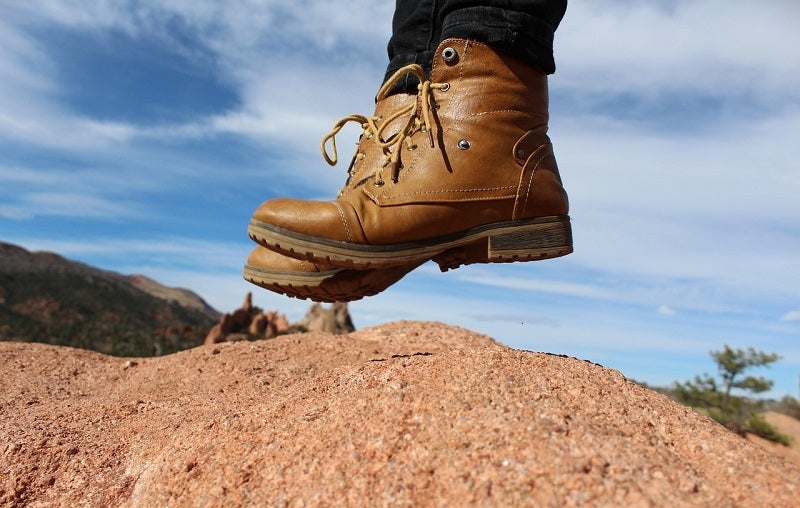
Lightweight Boots
Lightweight hiking boots going to be the most flexible and versatile for hiking boots. They are usually tough enough for a weeklong hike and of course shorter day hikes. These types of hiking boots are made from more synthetic and mesh materials than leather to save on weight.
As a result they tend to be cheaper, lighter and less durable than their leather constructed cousins. With a more flexible design, they will not provide the same amount of support, depending on where you are hiking and the terrain this may not be an issue.
Midweight Boots
In the middle and a compromise between lightweight and heavyweight womens hiking boots are the midweights. This boot offers more support with a stronger, more durable sole and upper.
Also more leather and waterproofing is available with the heavier weight. This type of boot is ideal for longer hikes over terrain that is not too difficult and rocky. If you are
Heavyweight
Here we have full on support and protection for your feet with a cost of weight. In this categories were going to find full grain leather boots with full waterproofing.
Stiffness and less flexibility are a notable downside but you gain more support for hiking with a heavier load like with a full pack or a baby carrier.
If you plan on hiking over rocky, rough terrain, this type of backpacking boot is almost a necessity. Something to keep in mind with this type of boot is the break in period. Do not just head out on the trail for a weeklong hike without a prior break in period.
Mountaineering Boots
For hikers who stray into the technical world of mountaineering, these boots are a must have eventually. However, the vast majority of us do not need mountaineering boots and they’re really inappropriate for most hiking applications.
Mountaineering boots are very expensive and they’re designed for very specific applications. There’s no sense in wearing mountaineering boots on a normal hike because they’re heavy, stiff, and made to handle add-ons like crampons.
I know when I first started hiking, mountaineering boots seemed super cool. They’re fancy looking at I always thought to myself, “Hey, the pros must use these!”
Don’t get duped into buying some unless you’re actually mountaineering. You’ll know when you need them.
Hiking Shoes vs Hiking Boots
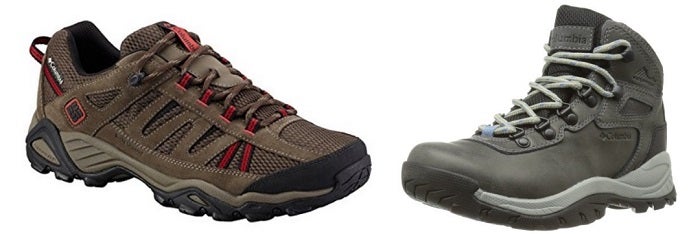
Before heading out on your hiking trip one of your first and most important decisions will be whether to go with hiking boots or shoes. Both have major strengths’ and weaknesses.
The primary decision will come down to how much support (for your ankles) and stability over rough terrain. If your carrying a heavier load over rougher terrain, a boot is probably your best option.
On the other hand, for trails with a light load, a hiking shoe is almost always a better choice.
Waterproofing
All of the boots on our list are waterproof and this will protect your feet under most circumstances of rain, mud or puddles. The most popular method of waterproofing is Gore-Tex which is not only provides waterproofing but also gives the boot breathability.
The Gore-Tex is normally a layer that is sandwiched between the outer layer and inner liner. Gore-Tex is no longer the only waterproofing method, many boot manufactures have come up with their own proprietary methods that work just as well.
In addition to the waterproof liner, most boots are treated with a coating to resist water and provides the first layer of waterproofing.
While most all boots are waterproof this is not always a good thing. Reason being is the same properties that make the boot waterproof also can trap moisture in the boot. After a long day of hiking your feet are going to get sweaty and even though boots do provide some level of breathability to let some moisture out, it does not let it all out.
In my opinion the advantages of keeping your feet dry from rain, puddles and streams outweigh the downsides of having slightly sweaty feet. The layer of waterproofing also adds a measure of insulation that can be helpful in cold weather.
If you only hike in dry weather, then you may want to skip waterproof boots and enjoy the extra breathability so your feet will dry by letting your sweat evaporate.
Stability
The primary purpose of a women’s backpacking boot is to provide stability and protection for your feet. To provide that stability, a shank is used. This is a stiff piece of plastic between the insole and outsole (around the arch of your foot) of the boot that gives the boot its strength and stiffness.
The more difficult and technical the terrain the more support and stiffness you need in your boot. A stiffer boot will result in less calf fatigue vs a hiking shoe. A more stable boot is usually comes at the cost of more weight.
For shorter hikes that are on trails I would highly recommend staying with a lighter more flexible boot like the Merrill Moab boot.
As you progress to longer and more technical terrain with a heavier load, a more stable boot like the Columbia Women’s Newton Ridge Plus Hiking Boot is a good choice.
Lacing
Perhaps one of the most overlooked parts of a hiking boots is the lacing setup of the boot. Cheaper boots tend to have a poor lacing setup that are not only harder to adjust to get a proper fit but also not stay adjusted and loosen up as you hike in the them.
The primary factor in the lacing setup of the boot is the laces themselves. A poor quality lace can be easily replaced with better ones. So if you notice them constantly loosing up, invest in some better laces.
Pro Tip: Look for boots where a hook is at the top of the boot like the Ahnu Women’s Sugarpine Boot Hiking Boot.
Breathability
Unfortunately, as we get more waterproofing in our boots we have to give something up. And that something is breathability. The same factors that make the boot waterproof also make it less breathable.
This means as your feet sweat, the moisture has a tougher time evaporating out of the boot.
This becomes especially important during the warmer summer months. The heavier and more stable full grain leather boots tend to be the least breathable and as a result, your feet will have a more difficult time shedding heat and sweat.
The Ahnu Women’s Sugarpine Boot Hiking Boot is a pretty good compromise between waterproofness and breathability. Boots with Gore-tex waterproofing tend to be the worst performers as far being breathable.
The same factors that make them so great for waterproofness also makes them terrible for breathability.
Toe Protection
A cap on the front of the boot will provide protection for your toes when you inevitably kick a rock or boulder. This thick piece of rubber will save your toes when you do this.
The Keen Targhee are a perfect example of a boot providing a toe cap with maximum protection. If you don’t plan on hiking rocky terrain you can probably forgo this feature as it does add some weight to the boots.
Insole
The insole will be a big factor in getting a good fit in your hiking boots. Cheaper boots tend to come with flat insoles that provide little support.
The good news is that can be easily changed by replacing them with a quality insole providing the support you need. If you need more arch support or more cushioning under the heel, this is an easy fix.
Hiking Boot Uppers
There are 3 major materials used the making of the boots “upper”. This is what connects to the outsole (bottom) of the boot. It will be primarily responsible for the boots waterproofness, durability and breathability.
Full Grain Leather
Found on heavyweight, durable boots. Full grain leather boots are usually one piece designs that provide waterproofness but also are the least breathable of materials.
One thing you should be aware of with full grain leather boots, like the Columbia Women’s Newton Ridge Plus Hiking Boot is they require period maintenance by treating the leather so it doesn’t dry out and to keep its waterproofness.
Suede and Nubuck
Suede, made form full grain leather that has been made to have a softer, more flexible structure. The finish is not glossy like full grain leather boots are. As a result they do not scuff and show marks like full grain leather.
Suede is also more breathable but not as waterproof or durable as full grain upper boots. It is often combine with a mesh to make them more lightweight but sacrificing water resistance. The Merrill Moab is a good example of this type of boot.
Mesh
Nylon, mesh is a feature of low-end hiking boots that are designed for lightweight and shorter, less technical terrain. This comes with the benefit of superior breathability, keeping your feet cooler and dryer.
This also comes with a cost of being a less durable, tough hiking boot. The Ahnu Women’s Sugarpine Boot Hiking Boot does a good job with being of a mesh design but with a level of toughness and waterproofness not found on most other boots of this type.
Traction
Where hiking boots shine is when you are hiking over technical terrain that is rocky, wet and steep. The aggressive tread patterns on most hiking boots will give you the confidence to hike over this type of terrain.
Vibram soles are usually a popular feature amongst hiking boots to provide the extra grip and traction needed. There are of course various designs in the soles that make some better than others.
Larger lugs on the Keen Targhee give them superior traction for wet and muddy terrain. While a stickier sole found on the Merrill Moab are better for rocky terrain.
Other Considerations For Boots:
Insoles
Lastly we’ll discuss the boot insoles. Arguably one of the most important parts of the boot that make a huge difference in comfort. Most boots come standard with a flat insole that will be ok for most people but if your feet have high arches or you suffer from plantar fasciitis you will want to swap out the insole with something that fits your foot better.
Luckily this is super easy to do, just pull out the insole and replace it with one designed for your specific feet. Doing so will support your feet properly and make for a comfortable day on the trail
Snake Bites
It seems that irrational fear of animals is one of the biggest myths about hiking, backpacking, and wilderness travel. I can’t tell you how many “survival” shows or outdoor shows I’ve seen with and unhealthy focus on animal attacks. Of course, snake bites do happen.
However, you’ll want to consider where you’ll be traveling and how likely a snake encounter is. If this is a real threat, I’d suggest looking at buying snake boots – they’re a specific type of boot.
While snake boots might be helpful in some areas with extremely high danger of snake encounters, very few of them are well made for long travel durations.
Because of their high-top and rugged design, they’re also uncomfortable and blister-prone. Only seek these boots if snake bites are a real and legitimately likely life threatening aspect of hiking in your chosen location.
The True Cost of Heavy Footwear
The saying goes that “one pound on your feet equals five pounds on your back” and it couldn’t be more true. According to many studies, empirical evidence, and a large body of writing, “Weight on the feet is disproportionately more exhausting than weight carried on the torso.”
Why is this so? Because once under motion your torso, pack, and body remain under motion during normal hiking conditions. Your feet, however, do not.
When walking, your feet must constant accelerate and stop with every step and, if you remember from physics class, it takes a lot more energy to get something started moving than to keep it moving.
Every time you pick up and put your feet down, any extra weight on them is going to make it harder and harder to do so – expending more energy.
Don’t believe me? Log a 25-mile hiking day with beefy over-the-ankle hiking boots on your feet and then compare it to a 25-mile day with a well-fitting pair of lightweight Women’s hiking boots.
You’ll feel the difference. No matter what type of footwear you decide is appropriate for you, lighter is always better!
Are Waterproof Boots Necessary?
Many new hikers are obsessed with waterproof gear. Waterproof backpacks, sleeping bags, tents, shoes, boots, and everything else under the sun.
Waterproof footwear has several huge and glaring drawbacks and we’ll talk about a few of them here:
Water can still come in from the top of the boot where your foot goes in. If you step in water deeper than the boots cuff (river crossing or deep puddles) or if rain leaks down your legs or rain pants (almost guaranteed) then your waterproof boot is now a swimming pool for your foot.
Even breathable waterproof footwear will retain moisture and standing water for hours or even days. Waterproof membranes simply suck once water manages to get inside the boot – they just hold in the water and make your foot marinade in nasty foot water as your skin becomes dangerously macerated.
Waterproof membranes are fragile and breakdown quickly under abrasion and movement. In a shoe or boot critical wear points are subjected to constant flexion and abrasion from your foot, rocks, dirt, pebbles, and other grit both inside and outside the shoe.
Almost without exception the waterproof membrane will break down before the boot does and now you’re left with a functionless waterproof piece of footwear.
The only time I use or value waterproof hiking boots is in shoulder season conditions where trails may be muddy, snowy, or icy. In these conditions getting your feet wet can be dangerous or harmful and staying dry and warm as long as possible is always prudent.
In these conditions, it is necessary to consider some method by which to keep your feet safely warm and dry – either waterproof socks, vapor barriers, trash bag liners, or waterproof footwear.
FAQs About Women’s Hiking Boots
Q: What are gaiters and do I need them?
A: Hey, you’ve probably seen people hiking with big leather boots and tall covers that go up to the knee, right? Those tall covers are called gaiters.
Gaiters are there to keep wind, rain, rocks, sticks, and other crap out of your boots and shoes. In the case of rain they won’t help much in most cases, but they do a good job of adding a layer of defense against thorns and bushes.
Gaiters can be used to either help protect the leg off trail or to keep debris out of shorter running shoes on the trail. If you’re staying on trail look for short, lightweight gaiters like the Dirty Girl Gaiters. For off-trail or winter hiking go with something robust like a good pair of Outdoor Research gaiters.
Q: Are waterproof breathable boots worth my money?
A: This is a tough question and I’ve tried to answer it many times. What it boils down to is when and where you’re hiking.
The main problem with waterproof footwear is the giant hole in the top of the boot where rain or puddles can get into the boot. Once this happens the boot just becomes a swamp.
For shoulder seasons like cold fall and cold spring hiking you might get some benefit from a WPB hiking boot. Otherwise I’d normally advise that you go with a lightweight pair of boots and just accept the fact that your feet will get wet.
Q: What are lugs on a boot?
A: You might find this term being bandied about and what it really means is quite simple. Lugs are the big treads on the sole of a hiking boot around the edge.
Lugs are normally quite large and pronounced. They often protrude like aggressive mud tires on an offroad truck. Lugs are ideal for muddy hiking where they do a good job of digging into the soft dirt and providing traction.
Look for robust lugs on your hiking boots if you plan to do hiking in wet or slick areas. Larger lugs do a better job of shedding mud while smaller ones can get packed full and become slick themselves.
Q: What is a toe cap?
A: Toe caps on hiking footwear are the little plastic or rubber protectors at the front of the boot. They’re put there to prevent you from ripping toenails off or bruising toes on rocks and roots as you hike.
If you’ve never kicked a rock or a root full speed when hiking because you’re just not paying attention then just give it time – you will. When that happens, lightweight fabric isn’t enough to protect your foot. In fact a toe injury like that, even if it’s just a swollen toe, can lead to problems on down the trail.
I’ve seen hikers evacuated for bruises, blisters, and jammed toes. Avoid a bad ending to your hike by using hiking boots with good toe caps that wrap up around the toes.
Q: Do I need custom insoles?
A: It really depends. If you have never had problems with your feet and shoes, then probably not.
If, on the other hand, you have had other shoes custom fitted or have had problems addressed by a doctor for posture or gait you may need to customize your footbed.
Many hikers use expensive aftermarket footbeds that can be installed at home. Talk to your doctor first to actually get a professional opinion on what type of insole adjustments you should make. Making the wrong ones can be a waste of money and time, worse it could even lead to a hiking athletic injury.
In the end, don’t try to guess and don’t change insoles just because some guy on the forums suggests it. Get a real opinion on the matter first and then you’ll be better informed by a medical professional who can give personalized advice.
Conclusion
Ladies, your choices in great hiking and backpacking footwear are improving every year. Luckily footwear makers have responded quickly to the evolving demands of all hikers in recent years and we now have so much more selection.
Remember that tall, heavy hiking boots can take a long time to break in. They’re blister-prone, and they’ll tire your legs out after a day of walking in them. Of course, this is the tradeoff we make for some waterproofness and ankle support.
Whether you need a pair of lightweight Women’s hiking boots or a pair of waterproof boots that engulfs the ankle and lower leg in a protective cocoon, you’ll be able to find it on our list.
Make sure to compare your needs against the features of the boot to avoid making a mistake when purchasing. Remember, every hiker has different preferences so go ahead and choose freely!
Best Women’s Hiking Boot Brands
 Merrell is one of my all time favorite brands for boots. All they make are footwear and they have been doing it for over 20 years. Columbia in my opinion is the best value proposition there is. Their gear is always of good quality at a reasonable price.
Merrell is one of my all time favorite brands for boots. All they make are footwear and they have been doing it for over 20 years. Columbia in my opinion is the best value proposition there is. Their gear is always of good quality at a reasonable price.
Keen manufactures a quality line of footwear for Men and Women, they are also heavy into protecting the environment and supporting non-profit causes. Ahnu may be the least known makers of footwear, but they are well known in the hiking community for making quality, reasonably priced hiking shoes and boots. They were recently acquired by Teva and hopefully will continue their tradition of making quality footwear.
I hope this guide was helpful for finding a good pair of women’s hiking boots to fit your needs. If you want to comment or recommend a pair of boots I didn’t include, please use my contact form to get in touch.
Have fun and be safe out there!
How We Researched
To come up with the top women’s hiking boots we researched a variety of sources for reviews such as REI, Bass Pro Shops, Cabelas and Backcountry along with our own personal experience.
We also consulted online magazines for product research and reviews to get as much unbiased information as we could. To help weed out fake reviews we used Fakespot.com to make sure we only looked at genuine reviews.
With so much quality gear available, we had to narrow it down based on what we felt were the best options for the price. The author, Casey Fiedler has been leading backpacking trips for over a decade in his native state of Michigan.
To help narrow down the selection he used his personal experience along with recommendations from fellow guides and outfitters.
After extensive research, we came up with our list to help you choose the right pair for you.

